The Intel SSD 600p (512GB) Review
by Billy Tallis on November 22, 2016 10:30 AM ESTAnandTech Storage Bench - The Destroyer
The Destroyer is an extremely long test replicating the access patterns of very IO-intensive desktop usage. A detailed breakdown can be found in this article. Like real-world usage and unlike our Iometer tests, the drives do get the occasional break that allows for some background garbage collection and flushing caches, but those idle times are limited to 25ms so that it doesn't take all week to run the test.
We quantify performance on this test by reporting the drive's average data throughput, a few data points about its latency, and the total energy used by the drive over the course of the test.
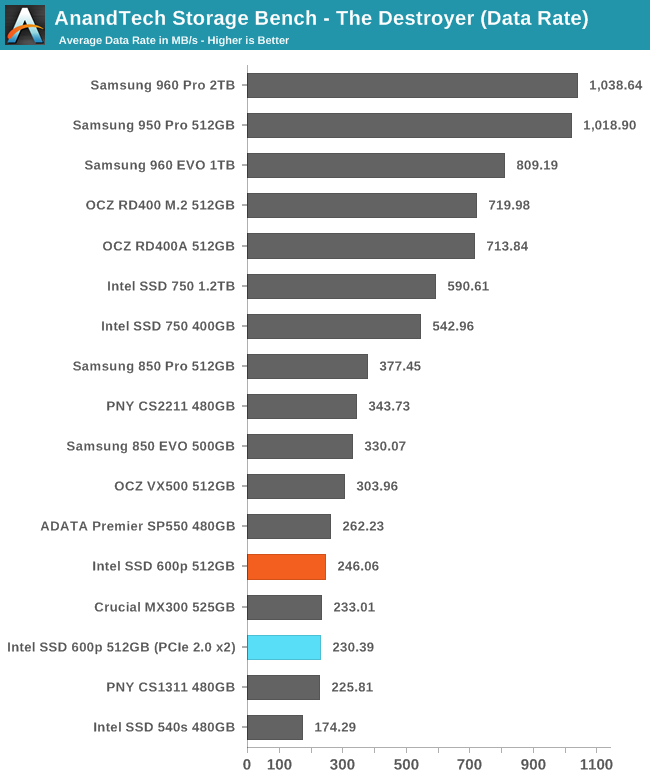
The average data rate sustained by the 600p on The Destroyer shows that the drive is almost entirely limited by the speed of the 3D TLC NAND, and it is barely any faster than the Crucial MX300 that uses the same NAND.
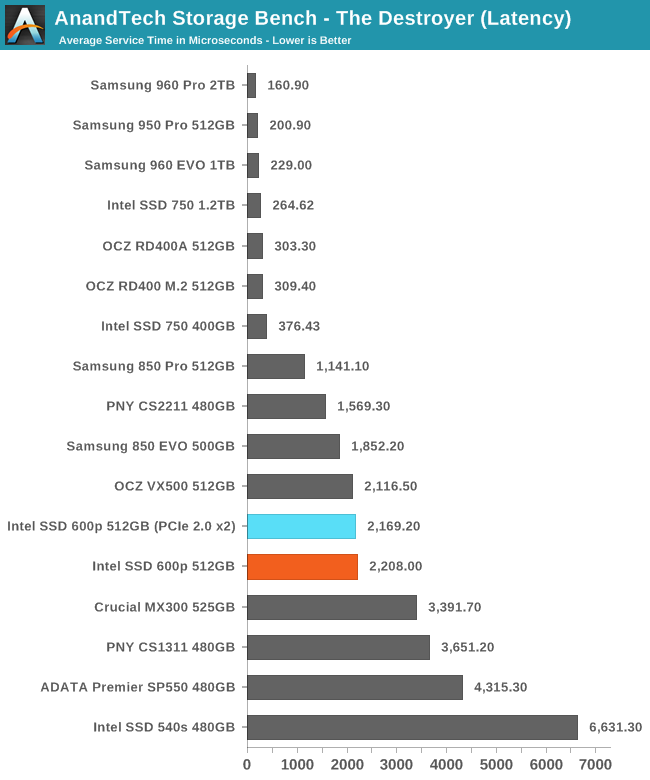
The average service time of the 600p is much lower than most TLC SSDs, so the NVMe PCIe interface is providing some latency benefit even when the drive's throughput doesn't need anything faster than SATA. The 600p is still only as good as a mid-range MLC SATA SSD and doesn't come close to the low latency of high-end NVMe drives.
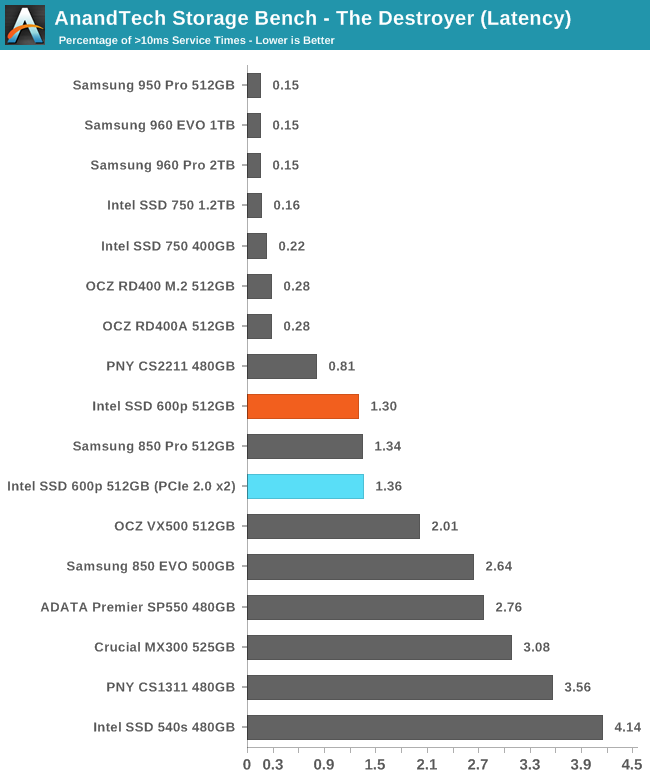
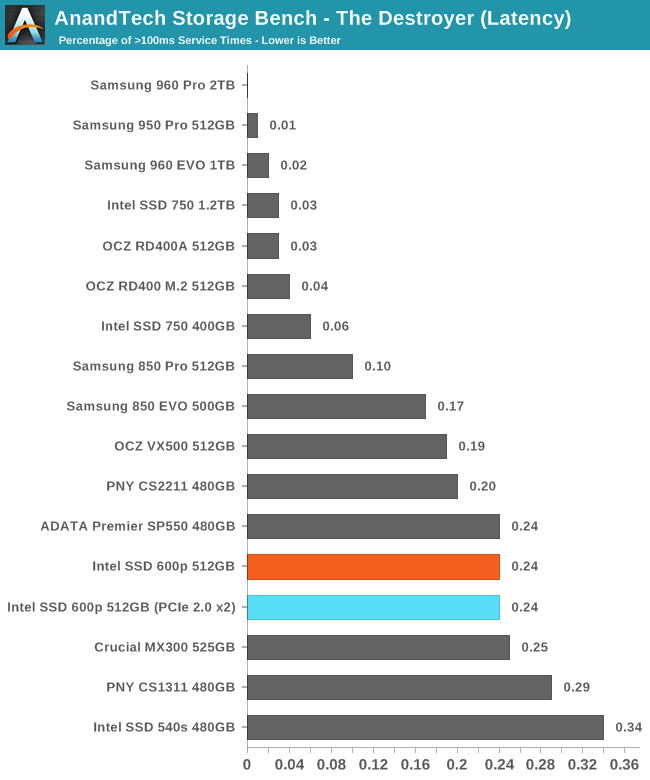
The number of high latency outliers above the 10ms threshold and above 100ms tells two quite different stories. The 600p is as good as most MLC SATA drives at completing most of its operations in under 10ms, but when the drive stalls, it does so as severely as a budget TLC SATA SSD.
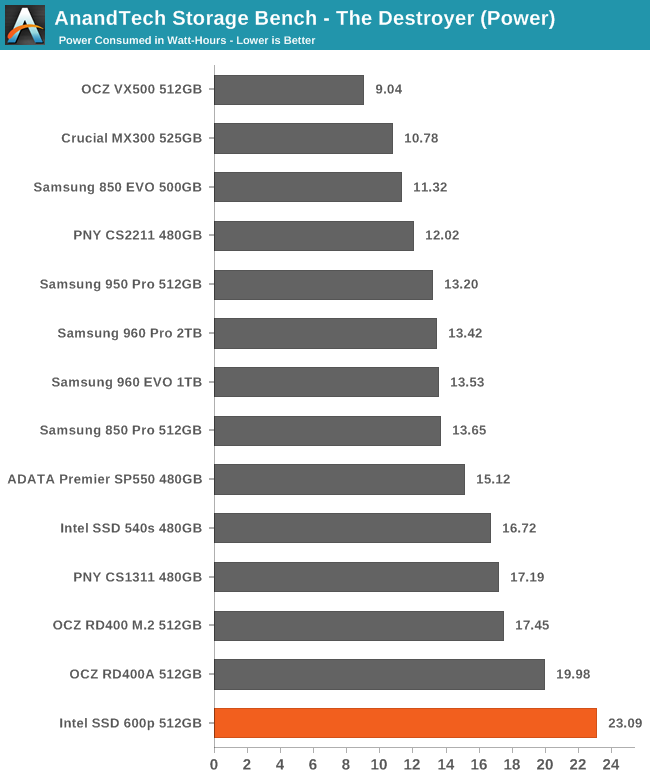
Operating a PCIe 3.0 x4 link requires quite a bit more power than a SATA link, so most PCIe SSDs start at a disadvantage in power consumption and make up for it by completing the test fast enough that the total energy used is not higher than is typical for SATA SSD. The 600p doesn't complete The Destroyer any quicker than a SATA SSD and the 40nm fab process used by the SM2260 controller doesn't do it any favors here either.










63 Comments
View All Comments
Billy Tallis - Tuesday, November 22, 2016 - link
The old firmware. The testbed has been too busy with PCIe SSDs lately for me to have a chance to put the November MX300 update through its paces.seanmac2 - Wednesday, November 23, 2016 - link
I would never intentionally buy this product but it bothers me anyway because laptops advertise things like "512 GB PCIe SSD" and I'm left wondering if I'll get this or something sweet like a Samsung 950/951/960.ddriver - Wednesday, November 23, 2016 - link
You get what you pay for. The 600p will likely go into budget products, which won't be CPU powerhouses which may be limited by the sdd performance. Most applications, even prosumer grade software, shows like 1-2$ improvement from going sata to nvme, and this particular product, although technically nvme is more in the sata ballpark.Flying Aardvark - Friday, November 25, 2016 - link
That's why Intel products cost more than others. You do get what you pay for. Intel SSDs have the industry's best reliability, which matters most when your drive fails prematurely. Unlikely if using M.2 you'll see any real world difference between the 600P and anything else.The true step up is the heavy duty Intel 750 stuff with heatsink and zero throttling concerns under heavy, sustained load.
Meteor2 - Wednesday, November 23, 2016 - link
A suggestion: you could link to the previous reviews of devices the first time you mention them, e.g. the 850 Evo. Would save hunting around for them/encourage more page views a people read those reviews before coming back.Meteor2 - Wednesday, November 23, 2016 - link
So where's this drive falling down compared to the other NVMe drives? Is it the TLC NAND, the construction of the dies, the controller, or something else?DominionSeraph - Wednesday, November 23, 2016 - link
"1750MB/s sequential read", and not a single test showing if it could actually reach 1750MB/s sequential read in any real life tasks.Great job there.
beginner99 - Wednesday, November 23, 2016 - link
WTF is this? It's another useless TLC crap drive. Intel, your ruining your reputation and brand with crap like this. I don't see why I should buy this over a MX300 or similar crappy TLC entry level ssd that is even cheaper.Flying Aardvark - Friday, November 25, 2016 - link
Everything is going to be 3D TLC soon except the truly next-level stuff like the Intel 750. 3D TLC is not planar TLC.creed3020 - Wednesday, November 23, 2016 - link
Billy, when are these results going to be included in Bench? I was hoping to compare to my Crucial MX100 but cannot find these Intel drives under SSD2015.